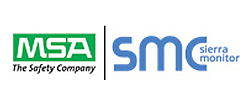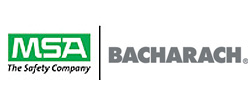

Home - Products - Toxic Gas Detection - Toxic Gas Detection

The SMC 5100-XX-IT gas detector monitors toxic gases such as Hydrogen Sulfide, Carbon Monoxide, Nitrogen Dioxide, Ammonia, Oxygen Deficiency, and others. The detector requires calibration only every six months, cutting operating costs and time. As part of the SMC Sentry IT platform, the detector can be remotely diagnosed and calibrated via Remote Sensor Capability.

Powerful gas detection system controller.
The SMC Sentry IT Controller is a powerful network-enabled hazardous gas detection system that operates up to 32 detectors and interfaces with devices over Modbus RTU, 4-20 mA, Sentry PSG Bus, and conventional dry contact. The embedded web application enables users to view important data remotely and provides connectivity into the Industrial Internet of Things (IIoT).

Electrochemical Toxic Gas Sensor Module 5100-XX-IT
Sierra Monitor’s fixed 5100-XX-IT gas module monitors toxic gases such as Hydrogen Sulfide (H2S), Carbon Monoxide (CO), Nitrogen Dioxide (NO2), Ammonia (NH3), Oxygen (O2) Deficiency, and others.
The 5100-XX-IT module is based on electrochemical technology, a proven, less-expensive option that offers high accuracy, low power requirements, and sensitivity to a particular gas in the parts-per-million range.
Electrochemical Toxic Gas Sensor Module 5100-88-IT
Sierra Monitor’s 5100-88-IT module monitors Carbon Dioxide (CO2), a toxic gas that is particularly dangerous in enclosed areas. This sensor monitors for adequate indoor air quality (IAQ) to ensure a healthy, comfortable, and productive work environment.
The 5100-88-IT module is based on infrared (IR) technology, an accurate and stable method of detection that requires low maintenance and can operate in low oxygen environments and not be poisoned by toxic gases.
Open Path Combustible Gas Detector Quasar 900
Sierra Monitor’s fixed 5100-XX-IT gas module monitors toxic gases such as Hydrogen Sulfide (H2S), Carbon Monoxide (CO), Nitrogen Dioxide (NO2), Ammonia (NH3), Oxygen (O2) Deficiency, and others.

The SMC 4501-XX Detector monitors toxic gases such as Hydrogen Sulfide, Carbon Monoxide, Oxygen Deficiency, Chlorine Dioxide, and others. Utilizing 2-wire loop-powered technology, the 4501-XX requires less wiring, leading to better protection from wiring errors. The 4501-XX requires minimal maintenance with a 6-month calibration cycle and continuous self-diagnostics.

Bacharach’s MGS-402 Gas Detection Controller centralizes the status of up to two gas detectors, provides a complete package for your safety compliance application. On the front panel of the MGS-402 a bank of LEDs corresponds to each connected gas detector; showing power, alarm status and fault indicators. The MGS-402 can provide the power requirements for to up to two gas detectors, which can be daisy-chained with Modbus communication to each gas detector; simplifying and reducing the cost of installation.

Bacharach’s MGS-408 Gas Detection Controller centralizes the status of up to 8 gas detection channels in a single location. The digital display provides a real-time view of the gas concentration and status at each gas detection point. It also allows for the controller to be configured in minutes vie the intuitive menu system. A bank of LEDs corresponds to each connected gas detector; showing power, alarm status and fault indicators.

Bacharach’s MGS-410 Gas Detector makes compliance with mechanical equipment room and refrigeration safety codes simple and easy, saving time and money on equipment and installation. Using the MGS-400 App, users can intuitively use, commission and maintain their gas detection system without the need for specialty training or tools. Pre-calibrated sensor modules simplify maintenance, take minutes to exchange and do not require the use of calibration gas. The MGS-410 sensor can trigger additional audio-visual alarms and act as a standalone gas detection system, or integrate easily into a BMS / BAS or with Bacharach’s MGS-402 or MGS-408 Gas Detection Controllers.

Bacharach’s MGS-450 Gas Detector makes compliance with refrigeration safety codes (ASHRAE 15, EN 378, CSA-B52) simple and effective, saving time and money on equipment and installation.

Bacharach’s MGS-460 Gas Detector makes compliance with mechanical equipment room and refrigeration safety codes simple and easy, saving time and money on equipment and installation. Using the MGS-400 App, users can intuitively use, commission and maintain their gas detection system without the need for specialty training or tools. Pre-calibrated sensor modules simplify maintenance, take minutes to exchange and do not require the use of calibration gas. The MGS-460 sensor can trigger additional audio-visual alarms and act as a standalone gas detection system, or integrate easily into a BMS / BAS or with Bacharach’s MGS-402 or MGS-408 Gas Detection Controllers.

Bacharach’s advanced MGS-550 Dual Gas Detector can utilize any combination of sensor technologies, including electrochemical, semiconductor (MOS), catalytic bead or infrared, in a single platform for unparalleled detection capability. It meets ASHRAE 15 and EN 378 requirements. The MGS-550 can easily be connected to any central control system using the current and volt analog output or the Modbus RTU interface. With three user assignable relays, it can also function as a stand-alone unit without the need to wire alarm devices back to a central system.

Bacharach’s MGS-460 Gas Detector makes compliance with mechanical equipment room and refrigeration safety codes simple and easy, saving time and money on equipment and installation. Using the MGS-400 App, users can intuitively use, commission and maintain their gas detection system without the need for specialty training or tools. Pre-calibrated sensor modules simplify maintenance, take minutes to exchange and do not require the use of calibration gas. The MGS-460 sensor can trigger additional audio-visual alarms and act as a standalone gas detection system, or integrate easily into a BMS / BAS or with Bacharach’s MGS-402 or MGS-408 Gas Detection Controllers.

The MVR-300™ VRF Refrigerant Gas Detector is specifically designed to provide continuous monitoring for refrigerants associated with high-efficiency, high volume refrigerant cooling and heating systems, such as VRF / VRV (Variable Refrigerant Flow/Variable Refrigerant Volume) systems. Typical applications include hotels, dormitories, hospitals, office buildings, and apartment buildings.

The MSA Bacharach® MGS-401 Entrance Monitor centralizes the status of up to four (4) MSA Bacharach diffusion Gas Detectors, which in turn provides and audible and visual alarm outside a monitored space. In addition, the MGS-401 displays any gas concentration level in the space for additional information and visual monitoring. System configuration will determine whether the alarms signals are addressed in the monitored space or at a controller or BMS/BAS level.